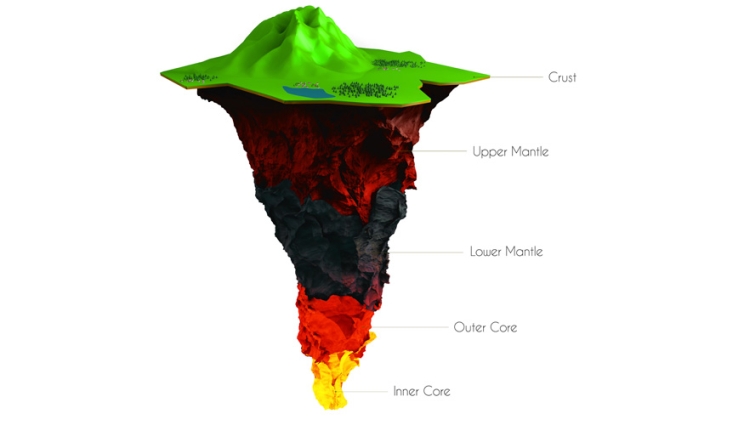Iron monoxide in Earth’s deep interior
 (Download Image)
(Download Image)
Cutaway view of Earth showing the crust, upper and lower mantle, and outer and inner core. (Adobe Stock.)
Iron monoxide (FeO), also known as wüstite in its mineral form, is a significant (even if not predominant) component of Earth’s core and the deep interior of Earth and other planets. Most notably, FeO exhibits a richness of condensed-matter phenomena, including crystal-structural phase transformations and melting, electronic transitions, and spin-state transitions that affect atomic structure and magnetic moments, that can significantly influence mantle convection, plume stability, and other internal planetary dynamics. For example, FeO has been known to undergo a metallization transition that is accompanied by a high-spin to low-spin electronic transition in iron, which can lead to dramatic changes in seismological (e.g., density and elasticity) and transport properties (e.g., electrical and thermal conductivity).
However, despite being an archetype for terrestrial planetary materials, FeO is poorly understood, and its phase diagram and electronic properties remain controversial, especially at high pressures and temperatures. Therefore, documenting the electronic state of iron in FeO (and other iron-bearing minerals) is thought to be essential for understanding the structure and evolution of Earth’s lower mantle and core-mantle boundary.
LLNL physicists and international collaborators are working to address these gaps in understanding, publishing their most recent research in Physical Review B (highlighted as an Editors’ Suggestion). The present study examined the phase diagram of FeO using state-of-the-art quantum mechanical density-functional theory (DFT) and dynamical mean-field theory (DMFT) calculations, along with x-ray diffraction (XRD) and x-ray emission spectroscopy (XES) measurements at simultaneously high temperatures and pressures. Such a combined experimental study is technically challenging and has rarely been attempted.
The experimental results and theoretical calculations document the complex interplay between electron states (revealing the existence of iron’s metallic high-spin state at the conditions near those of Earth’s core-mantle boundary) and structural phases, resulting in a rich phase diagram with significant variations in elastic properties. This suggests that wüstite, which may appear in the lowermost mantle due to chemical reactions at the core-mantle boundary, is metallic and could produce seismological anomalies caused by spin-state transitions at deep-mantle depths (∼1700−2000 km). Furthermore, enhanced electrical conductivity due to the presence of metallic FeO would influence heat transfer from Earth’s core into the mantle, as well as the temporal evolution of magnetic field lines crossing into the lower mantle.
This work prompts further investigation of the electronic states of Earth’s lower-mantle minerals as possible sources of seismic and chemical heterogeneity, as well as thermal instabilities.
[E. Greenberg, R. Nazarov, A. Landa, J. Ying, R.Q. Hood, B. Hen, R. Jeanloz, V.B. Prakapenka, V. V. Struzhkin, G. Kh. Rozenberg, I.V. Leonov, Phase transitions and spin state of iron in FeO under the conditions of Earth’s deep interior, Physical Review B (2023), DOI: 10.1103/PhysRevB.107.L241103.]
–Physical and Life Sciences Communications Team







